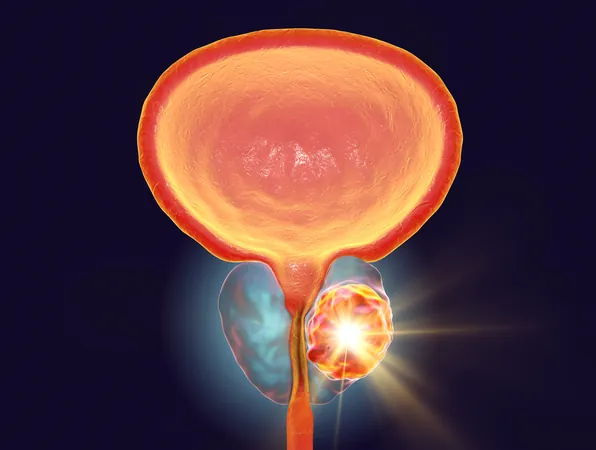
Revolutionizing Prostate Cancer Diagnosis: Microultrasound vs MRI-Guided Biopsy
2025-03-25
Author: Emma
Revolutionizing Prostate Cancer Diagnosis: Microultrasound vs MRI-Guided Biopsy
In a groundbreaking international clinical trial, researchers have revealed that biopsies guided by high-resolution micro-ultrasound (microUS) may be just as effective as those performed using magnetic resonance imaging (MRI) for diagnosing prostate cancer. This significant advancement could transform patient care by expediting diagnoses, reducing the number of hospital visits, and allowing for more efficient use of MRI machines.
The OPTIMUM Trial: A Pioneering Study
Presented at the European Association of Urology (EAU) Congress 2025 in Madrid and published in JAMA, the OPTIMUM trial is the first of its kind to directly compare microUS-guided biopsies with traditional MRI-guided biopsies. It involved 677 men at 19 hospitals across Canada, the U.S., and Europe. Participants were divided into three groups: half received MRI-guided biopsies, a third underwent both microUS and MRI-guided biopsies, and the remaining group only had microUS-guided biopsies.
Remarkably, the results demonstrated that microUS detected prostate cancer with rates comparable to MRI, effectively identifying significant cancers across all groups. This is a crucial finding that suggests microUS can serve as a reliable alternative to MRI in prostate cancer diagnosis.
Understanding the Benefits of Microultrasound
Traditionally, prostate cancer biopsies utilize MRI images fused with conventional ultrasound. This method requires multiple steps involving MRI scans followed by biopsies, necessitating specialist expertise. In contrast, microUS operates at a higher frequency than standard ultrasound, delivering images with three times the resolution and similar detail to MRI scans. This makes it easier for urologists and oncologists, who are already trained in ultrasound, to interpret the results.
Moreover, microUS is significantly more cost-effective than MRI, which permits onsite imaging and biopsies to be conducted in a single appointment—eliminating the need for multiple visits and increasing patient convenience. This one-stop-shop model could also alleviate the strain on MRI resources for other critical applications, such as evaluating joint conditions.
Expert Insights on the Findings
Dr. Laurence Klotz, the lead investigator of the OPTIMUM trial, expressed the potentially transformative nature of these findings, comparing the significance of microUS to the advent of MRI in prostate cancer detection. “MRI isn’t perfect—it has limitations like high costs and accessibility challenges,” he noted. “With microUS, we can achieve similar diagnostic accuracy without the associated risks and expenses.”
Dr. Jochen Walz, a prominent expert in urological imaging, emphasized that utilizing microUS simplifies the biopsy process while enhancing safety by reducing the risk of errors linked to fusing MRI and ultrasound images. He acknowledged the need for proper training to interpret microUS images effectively but asserted that once mastered, this technology could vastly improve access to prostate cancer diagnostics, particularly in less developed healthcare systems where MRI may be scarce.
A Vision for the Future
While the current findings are promising, further research is necessary to fully establish the role of microUS in prostate cancer screening programs. However, this innovative technology holds great potential not just for diagnosing prostate cancer efficiently, but also for broadening the capabilities of healthcare providers, ultimately improving patient outcomes.
As clinical trials continue and technology advances, the healthcare community stands on the brink of a new era in prostate cancer diagnosis, one that may prioritize accessibility, efficiency, and patient safety above all. Stay tuned for updates as this story unfolds!









 Brasil (PT)
Brasil (PT)
 Canada (EN)
Canada (EN)
 Chile (ES)
Chile (ES)
 Česko (CS)
Česko (CS)
 대한민국 (KO)
대한민국 (KO)
 España (ES)
España (ES)
 France (FR)
France (FR)
 Hong Kong (EN)
Hong Kong (EN)
 Italia (IT)
Italia (IT)
 日本 (JA)
日本 (JA)
 Magyarország (HU)
Magyarország (HU)
 Norge (NO)
Norge (NO)
 Polska (PL)
Polska (PL)
 Schweiz (DE)
Schweiz (DE)
 Singapore (EN)
Singapore (EN)
 Sverige (SV)
Sverige (SV)
 Suomi (FI)
Suomi (FI)
 Türkiye (TR)
Türkiye (TR)
 الإمارات العربية المتحدة (AR)
الإمارات العربية المتحدة (AR)